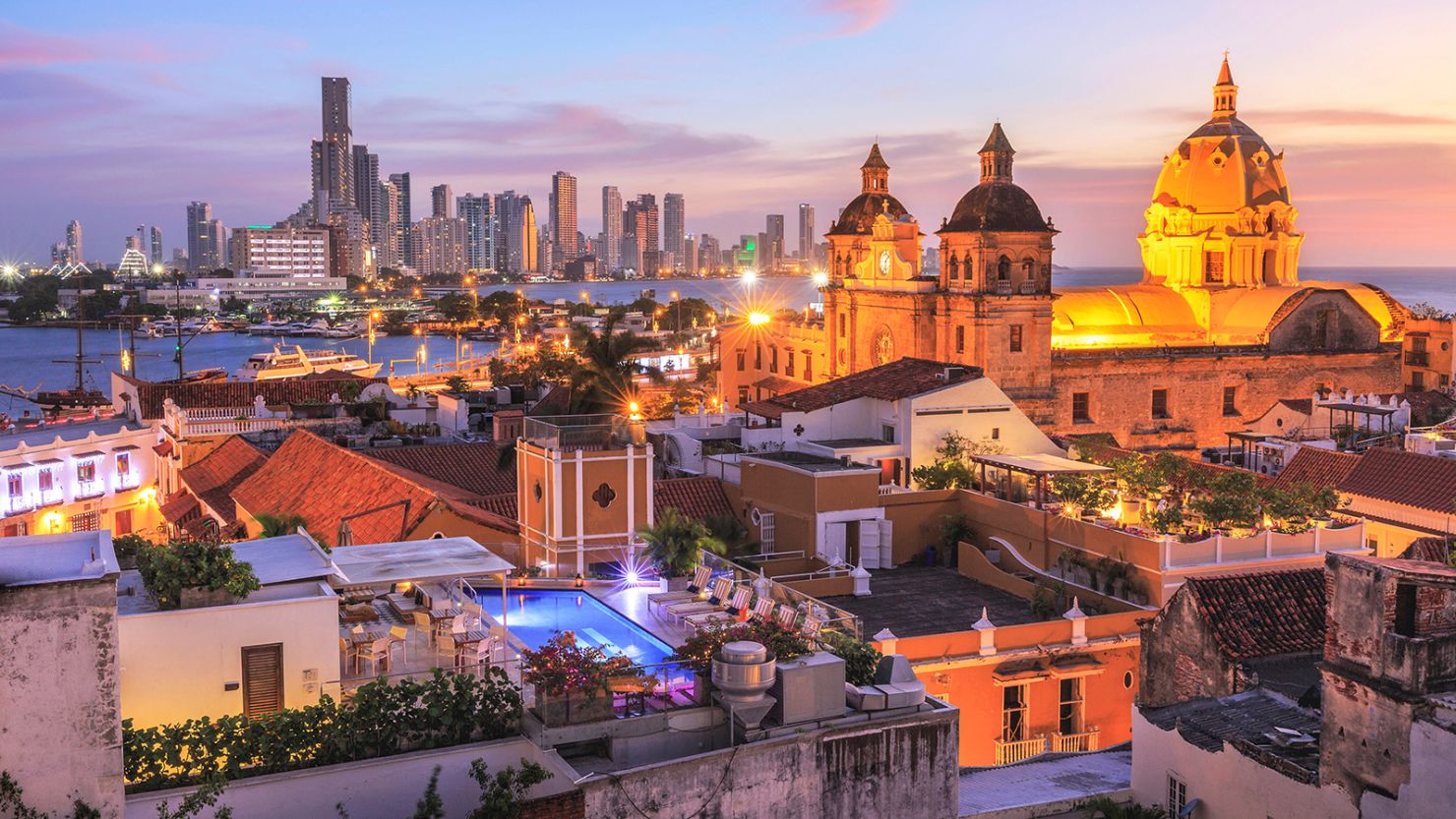Editor’s Note: Sign up for Unlocking the World, CNN Travel’s weekly newsletter. Get news about destinations opening and closing, inspiration for future adventures, plus the latest in aviation, food and drink, where to stay and other travel developments.
A popular Middle Eastern destination and a tiny Dutch Caribbean island were added to the CDC’s “high” risk category for travel on Monday.
The agency said on its website that it would continue to publish guidance for cruise ships, but its voluntary program for cruise ship monitoring ended effective on Monday.
In its separate list of Covid-19 travel notices, the South American countries of Colombia and Paraguay moved to the Level 3 “high” risk category along with Iraq in the Middle East and Kosovo and North Macedonia in the Balkans.
Level 3 became the top rung in terms of risk level in April after the CDC overhauled its ratings system for assessing Covid-19 risk for travelers.
The designation applies to places that have had more than 100 cases per 100,000 residents in the past 28 days.
Kosovo moved up two rungs this week from Level 1. The other four were previously listed as Level 2.
To recap, these five destinations received “high” risk designations on Monday:
• Colombia
• Iraq
• Kosovo
• North Macedonia
• Paraguay
There were about 115 destinations at Level 3 on July 18. Level 3 locations account for almost half of the roughly 235 places monitored by the CDC.
Level 4, previously the highest risk category, is now reserved only for special circumstances, such as extremely high case counts, emergence of a new variant of concern or health care infrastructure collapse. Under the new system, no destinations have been placed at Level 4 so far.
More on cruise ships
The CDC’s cruise ship color status page, which as of Friday listed most ships sailing in US waters as “highly vaccinated” and color-coded orange, has been removed.
The orange designation indicated that reported cases of Covid-19 on board had met the threshold for CDC investigation (0.3% or more of total passengers and/or crew). The color status system went from green to yellow to orange to red, with red status triggering additional Covid precautions.
The CDC said on its website that the color-coding system “depended upon each cruise line having the same Covid-19 screening testing standards, which may now vary among cruise lines. Therefore, the cruise ship color status webpage has been retired.”
The agency said it will continue to provide testing recommendations to cruise lines and that ships will still report Covid cases to the CDC. Passengers can contact cruise lines directly to find out about outbreaks on ships, the agency said.
The CDC said cruise lines have the tools and guidance to manage their own Covid mitigation.
“Additionally, cruise travelers have access to recommendations that allow them to make informed decisions about cruise ship travel.”
More on Level 3
Much of Europe has been stubbornly lodged at Level 3 for months with the summer travel season in full swing. As of June 27, the following popular European destinations were among those remaining at Level 3:
Much of Europe has been stubbornly lodged at Level 3 for months with the summer travel season now in a traditionally busy August. The following popular European destinations were among those remaining at Level 3 as of August 8:
• France
• Germany
• Greece
• Ireland
• Italy
• The Netherlands
• Norway
• Portugal
• Spain
• United Kingdom
Those aren’t the only high-profile spots that find themselves at Level 3. Numerous other destinations around the world are among those in the “high” risk category, including the following:
• Brazil
• Canada
• Costa Rica
• Malaysia
• Mexico
• South Korea
• Thailand
• Turkey
The CDC advises that you get up to date with your Covid-19 vaccines before traveling to a Level 3 destination. Being “up to date” means you have had not only the full initial vaccinations but any boosters for which you’re eligible.
Level 2

Destinations carrying the “Level 2: Covid-19 Moderate” designation reported 50 to 100 Covid-19 cases per 100,000 residents in the past 28 days. The CDC moved four places to this level on Monday:
• Azerbaijan
• Kyrgyzstan
• Senegal
Six of the seven places are in Africa.
The move was good news for Eswatini, Lesotho and South Africa, which all moved down from Level 3.
Gabon, Côte d’Ivoire and Mauritania all moved up in risk level from Level 1. The Central American country of El Salvador also moved up one risk level.
There are a total of 21 places in the “moderate” risk category this week.
You can view the CDC’s risk levels for any global destination on the agency’s travel recommendations page.
In its broader travel guidance, the CDC has recommended avoiding all international travel until you are fully vaccinated.
Level 1
To be listed as “Level 1: Covid-19 Low,” a destination must have had 49 or fewer new cases per 100,000 residents over the past 28 days. Two places were added to the category on August 8:
A few of the more popular places in the “low” risk category this week include Indonesia, India and the Philippines.
A few of the more popular places in the “low” risk category this week include Indonesia, India and the Philippines.
Unknown
Finally, there are the destinations the CDC has deemed to be of “unknown” risk because of a lack of information. Usually, but not always, these are small, remote places or places with ongoing warfare or unrest.
The CDC advises against travel to these places precisely because the risks are unknown. Other destinations in this category that typically draw more tourist attention include the Azores, Hungary and the Maldives.
There are about 65 places listed as “unknown” this week, making up more than one-quarter of all the places monitored.
A medical expert weighs in on risk levels
Transmission rates are just “one guidepost” for travelers’ personal risk calculations, according to CNN Medical Analyst Dr. Leana Wen.
We’re in “a phase in the pandemic where people need to make their own decisions based on their medical circumstances as well as their risk tolerance when it comes to contracting Covid-19,” according to CNN Medical Analyst Dr. Leana Wen.
There are other factors to weigh in addition to transmission rates, according to Wen.
“Another is what precautions are required and followed in the place that you’re going and then the third is what are you planning to do once you’re there,” she said.
“Are you planning to visit a lot of attractions and go to indoor bars? That’s very different from you’re going somewhere where you’re planning to lie on the beach all day and not interact with anyone else. That’s very different. Those are very different levels of risk.”
Vaccination is the most significant safety factor for travel, since unvaccinated travelers are more likely to become ill and transmit Covid-19 to others, Wen said.
And it’s also important to consider what you would do if you end up testing positive away from home.
While US-bound travelers no longer have to present a negative Covid-19 test to get home from international destinations, the CDC still advises testing before boarding flights back to the States and not traveling if you are sick.
“Of course, if people have symptoms or exposure while traveling, they need to get tested, and if they test positive, to follow CDC’s isolation guidelines,” Wen told CNN Travel.
If you’re concerned about a travel-specific health situation not related to Covid-19, check here.
Top image: A night view of Cartagena de Indias, a popular coastal city in Colombia. (sunsinger/Adobe Stock)




